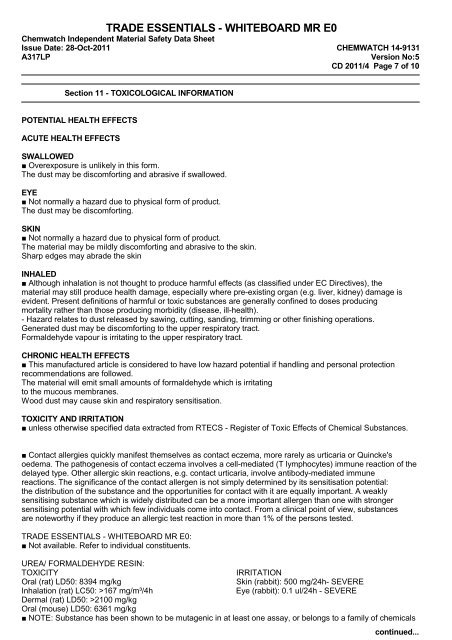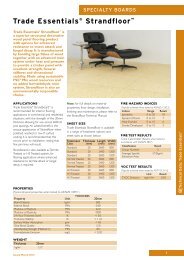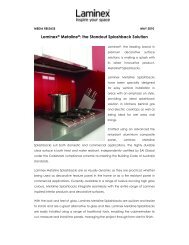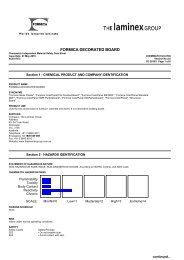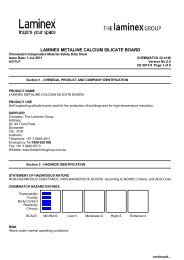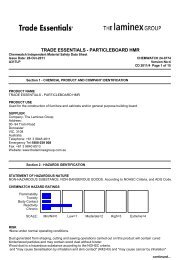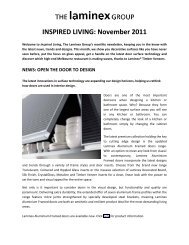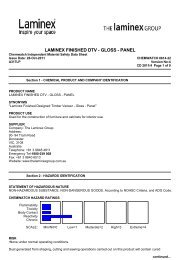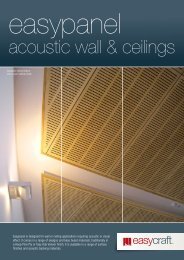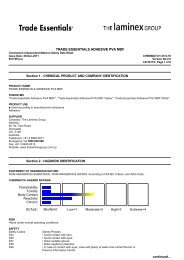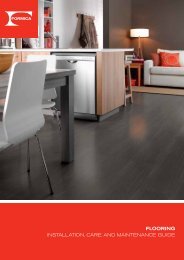Trade Essentials Whiteboard MR E0 MSDS 14-9131 - The Laminex ...
Trade Essentials Whiteboard MR E0 MSDS 14-9131 - The Laminex ...
Trade Essentials Whiteboard MR E0 MSDS 14-9131 - The Laminex ...
Create successful ePaper yourself
Turn your PDF publications into a flip-book with our unique Google optimized e-Paper software.
TRADE ESSENTIALS - WHITEBOARD <strong>MR</strong> <strong>E0</strong>Chemwatch Independent Material Safety Data SheetIssue Date: 28-Oct-2011 CHEMWATCH <strong>14</strong>-<strong>9131</strong>A317LPVersion No:5CD 2011/4 Page 7 of 10Section 11 - TOXICOLOGICAL INFORMATIONPOTENTIAL HEALTH EFFECTSACUTE HEALTH EFFECTSSWALLOWED■ Overexposure is unlikely in this form.<strong>The</strong> dust may be discomforting and abrasive if swallowed.EYE■ Not normally a hazard due to physical form of product.<strong>The</strong> dust may be discomforting.SKIN■ Not normally a hazard due to physical form of product.<strong>The</strong> material may be mildly discomforting and abrasive to the skin.Sharp edges may abrade the skinINHALED■ Although inhalation is not thought to produce harmful effects (as classified under EC Directives), thematerial may still produce health damage, especially where pre-existing organ (e.g. liver, kidney) damage isevident. Present definitions of harmful or toxic substances are generally confined to doses producingmortality rather than those producing morbidity (disease, ill-health).- Hazard relates to dust released by sawing, cutting, sanding, trimming or other finishing operations.Generated dust may be discomforting to the upper respiratory tract.Formaldehyde vapour is irritating to the upper respiratory tract.CHRONIC HEALTH EFFECTS■ This manufactured article is considered to have low hazard potential if handling and personal protectionrecommendations are followed.<strong>The</strong> material will emit small amounts of formaldehyde which is irritatingto the mucous membranes.Wood dust may cause skin and respiratory sensitisation.TOXICITY AND IRRITATION■ unless otherwise specified data extracted from RTECS - Register of Toxic Effects of Chemical Substances.■ Contact allergies quickly manifest themselves as contact eczema, more rarely as urticaria or Quincke'soedema. <strong>The</strong> pathogenesis of contact eczema involves a cell-mediated (T lymphocytes) immune reaction of thedelayed type. Other allergic skin reactions, e.g. contact urticaria, involve antibody-mediated immunereactions. <strong>The</strong> significance of the contact allergen is not simply determined by its sensitisation potential:the distribution of the substance and the opportunities for contact with it are equally important. A weaklysensitising substance which is widely distributed can be a more important allergen than one with strongersensitising potential with which few individuals come into contact. From a clinical point of view, substancesare noteworthy if they produce an allergic test reaction in more than 1% of the persons tested.TRADE ESSENTIALS - WHITEBOARD <strong>MR</strong> <strong>E0</strong>:■ Not available. Refer to individual constituents.UREA/ FORMALDEHYDE RESIN:TOXICITYIRRITATIONOral (rat) LD50: 8394 mg/kgSkin (rabbit): 500 mg/24h- SEVEREInhalation (rat) LC50: >167 mg/m³/4hEye (rabbit): 0.1 ul/24h - SEVEREDermal (rat) LD50: >2100 mg/kgOral (mouse) LD50: 6361 mg/kg■ NOTE: Substance has been shown to be mutagenic in at least one assay, or belongs to a family of chemicalscontinued...


